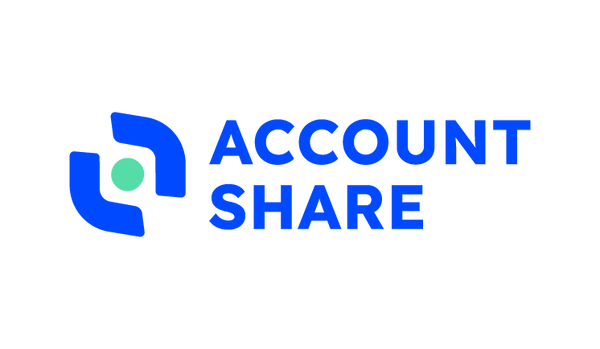
how can i remove advertisements on youtube - legal tips
Share
Let's be honest, YouTube ads can get a little... much. When you're trying to dive into a tutorial or just relax with a video, those constant interruptions can be a real pain. The good news is, you've got several solid ways to reclaim your viewing experience. The most official route is a YouTube Premium subscription, but if you're watching on a computer, browser ad blockers are a game-changer. For mobile, it's a slightly different story, often involving third-party apps.
Understanding Your Ad-Free Options
So, you're tired of being a captive audience for yet another ad. You're definitely not the only one. The push for an ad-free YouTube has sparked a whole ecosystem of solutions, from paid subscriptions straight from Google to clever tools built by independent developers. Each one has its own pros and cons, so it's worth figuring out which one fits your style.
The most direct, no-fuss method is paying for YouTube Premium. It's a huge part of YouTube's business model. In 2024 alone, the platform's ad revenue was projected to be around $36.1 billion, which is their biggest source of income. To offer an alternative, YouTube Premium has exploded in popularity, rocketing past 125 million subscribers globally by early 2025. It's their official answer to the ad problem.
This infographic breaks down the main choices you have, depending on what device you're using.
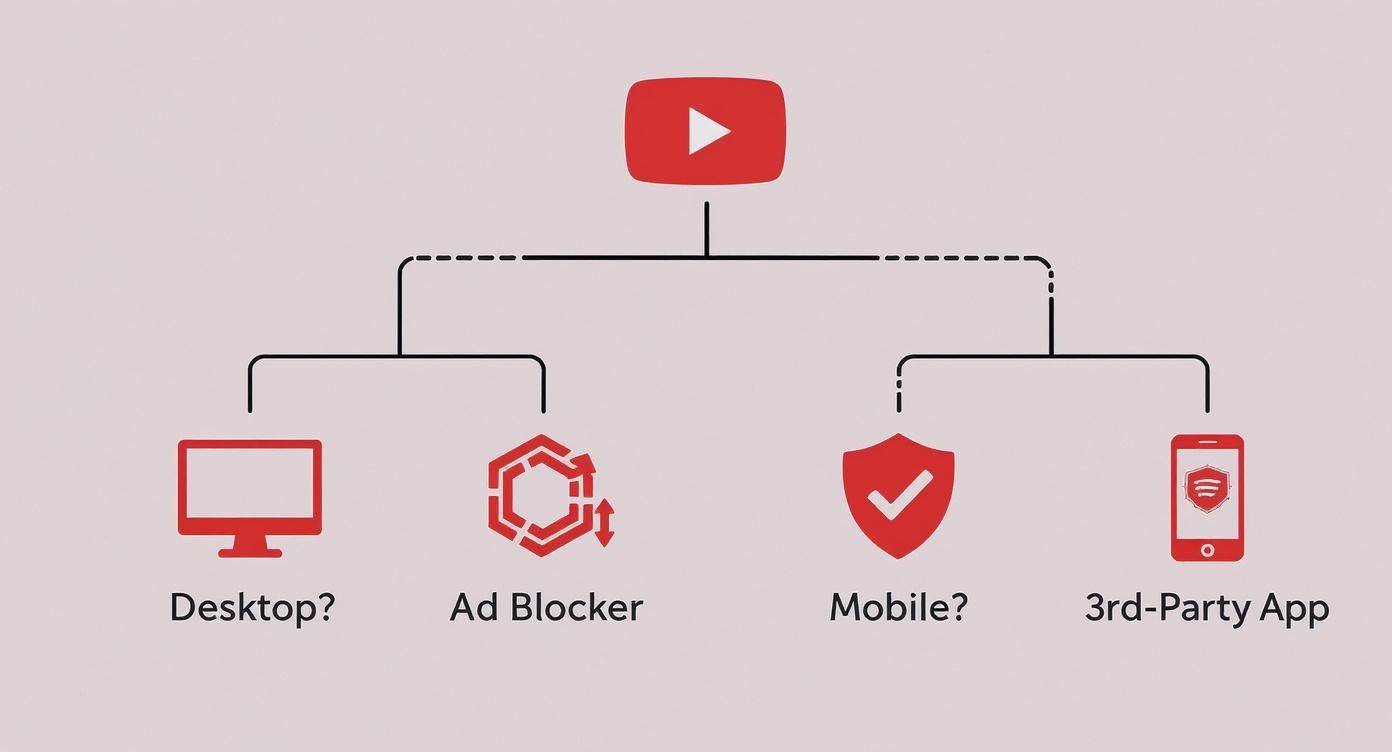
As you can see, whether you're on a desktop or a phone really steers you toward the best free solution.
Key Paths to an Ad-Free Experience
How you watch YouTube is the biggest factor here. Your strategy for a peaceful, ad-free session will boil down to one of these main approaches.
- Browser Extensions: This is the go-to for anyone on a laptop or desktop. These little add-ons work right in your browser to stop ads from ever loading. Simple and effective.
- Third-Party Mobile Apps: If you're always on your phone, you might look into unofficial apps. These often mimic the YouTube interface but strip out all the commercial breaks.
- Official Subscription: YouTube Premium is the universal soldier. It works everywhere you're signed in—phone, tablet, TV, computer—and throws in extras like background playback.
The right choice really comes down to a trade-off between cost, convenience, and how much you want to tinker. Ad blockers are fantastic and free, but sometimes they need a little update or adjustment. Premium is the "set it and forget it" option that just works.
If you're running into other barriers, like videos being blocked in your region, it's also worth looking into different methods to unblock YouTube to get full access to the content you want.
To make things even clearer, let's break down the main options in a quick comparison.
Quick Guide to Removing YouTube Ads
| Method | Best For | Cost | Pros | Cons |
|---|---|---|---|---|
| YouTube Premium | All-device users who want a simple, official solution. | Monthly Fee | Works on all devices, includes music streaming, supports creators. | The only option with a recurring cost. |
| Browser Ad Blockers | Desktop and laptop users watching in a web browser. | Free | Highly effective, easy to install, often blocks other web ads. | Doesn't work on mobile apps; can sometimes be detected by sites. |
| Third-Party Apps | Mobile users looking for a free ad-free experience. | Free | No ads, often includes features like background play. | Not on official app stores; can pose security risks. |
| VPNs/Proxies | Users who also want to bypass geo-restrictions. | Varies | Can block some ads; unlocks region-locked content. | Ad-blocking isn't their main job; can slow down your connection. |
Ultimately, whether you decide to pay for convenience or use a free tool, you have more control over your YouTube experience than ever before.
Using Ad Blockers on Your Desktop Browser
If you do most of your YouTube watching on a computer, a good browser extension is your best friend for getting rid of ads. These aren't just simple filters; they're your first line of defense, catching and stopping ad content before it even has a chance to load. Think of them as a bouncer for your browser.
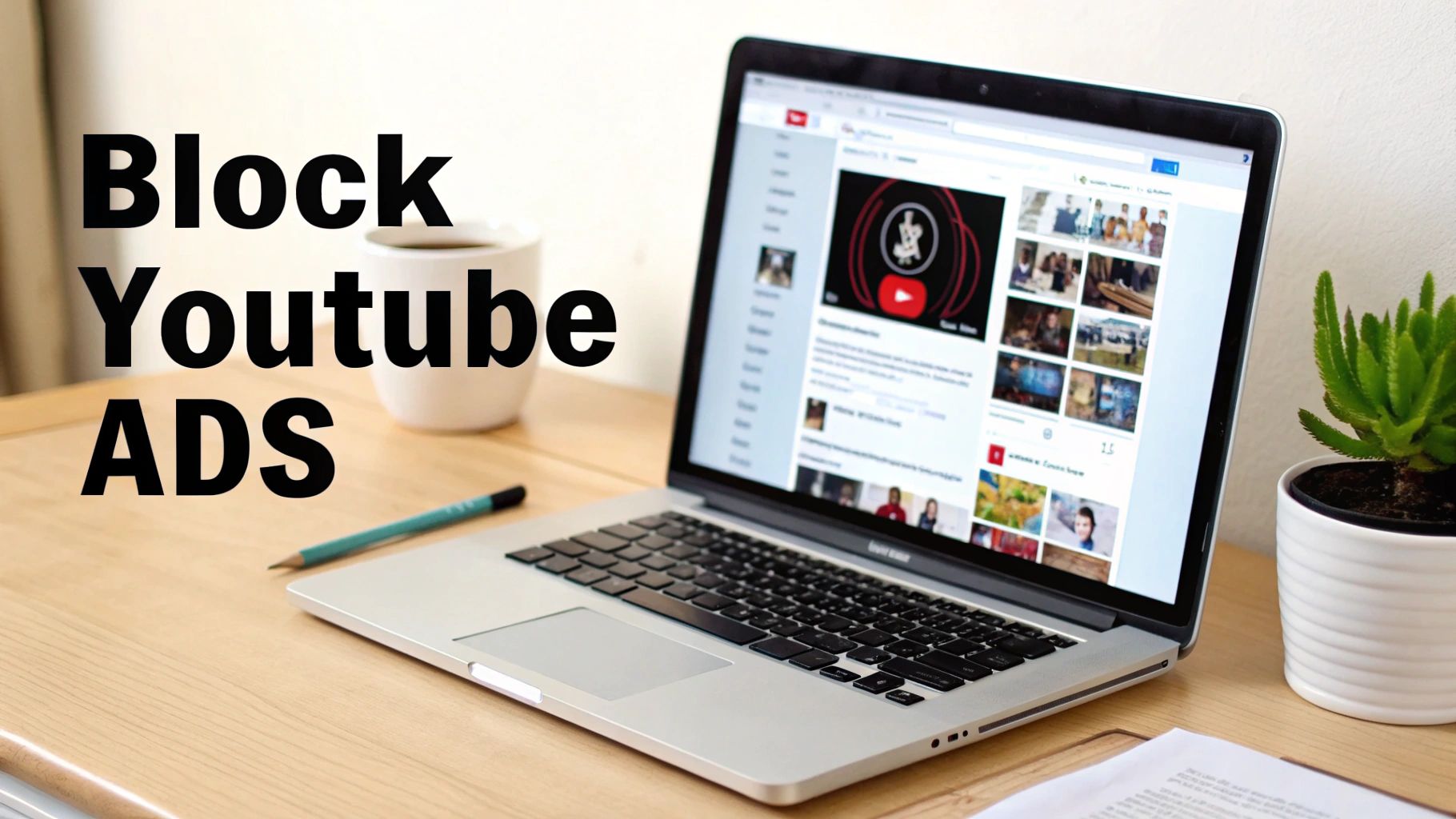
Popular choices like uBlock Origin and AdGuard are powered by massive, constantly updated "filter lists." These lists are basically a huge directory of all the servers and web addresses known for pushing ads. When you click on a YouTube video, the extension scans everything trying to load, checks it against the list, and blocks anything that's a match.
It all happens in the blink of an eye, leaving you with a clean, uninterrupted video. The best part is that the most effective ad blockers are totally free and work on all the big browsers like Chrome, Firefox, and Edge.
Choosing and Installing Your Ad Blocker
Getting set up is incredibly simple. Just head over to your browser's official extension marketplace—like the Chrome Web Store or Firefox Add-ons—and search for a well-regarded ad blocker. Installation is usually just a single click.
Once it's installed, the extension just works quietly in the background. You'll see the difference right away. Pre-roll ads, those annoying mid-video interruptions, and the banner ads cluttering the page? Gone.
One of the biggest perks is that these tools don't just work on YouTube. They block ads almost everywhere online, which makes your entire browsing experience faster and way less cluttered.
While many ad blockers also get rid of tracking scripts, you can take your privacy a step further. It's a good idea to periodically delete tracking cookies yourself for an extra layer of control over your data.
Troubleshooting and Supporting Creators
Now and then, YouTube will tweak how it delivers ads, which might let an ad slip through or even cause a video to hang. It’s a constant cat-and-mouse game, and this is a normal part of it.
If you hit a snag, here are a few things to try:
- Update Your Filter Lists: This is the go-to fix. Dive into your ad blocker's settings and find the option to manually refresh or update the filter lists.
- Clear Your Browser Cache: Old, stored data can sometimes mess with how the blocker functions. A quick cache clear can often fix weird loading issues.
- Whitelist Your Favorite Channels: Want to make sure a specific creator gets paid? Most ad blockers let you "whitelist" their channel. This simply tells the extension to stand down for their videos, allowing ads to play and support them directly.
Exploring Third-Party Apps for Mobile Viewing
When you’re away from your desktop, the fight against YouTube ads shifts to your phone. The problem is, browser extensions don't work inside the official YouTube app, which sends a lot of people looking for alternative solutions.
This is where third-party applications, often called "modded clients," come into the picture. These are essentially rebuilt versions of the YouTube app, specifically designed to cut out the ads and often pack in extra perks like background playback.
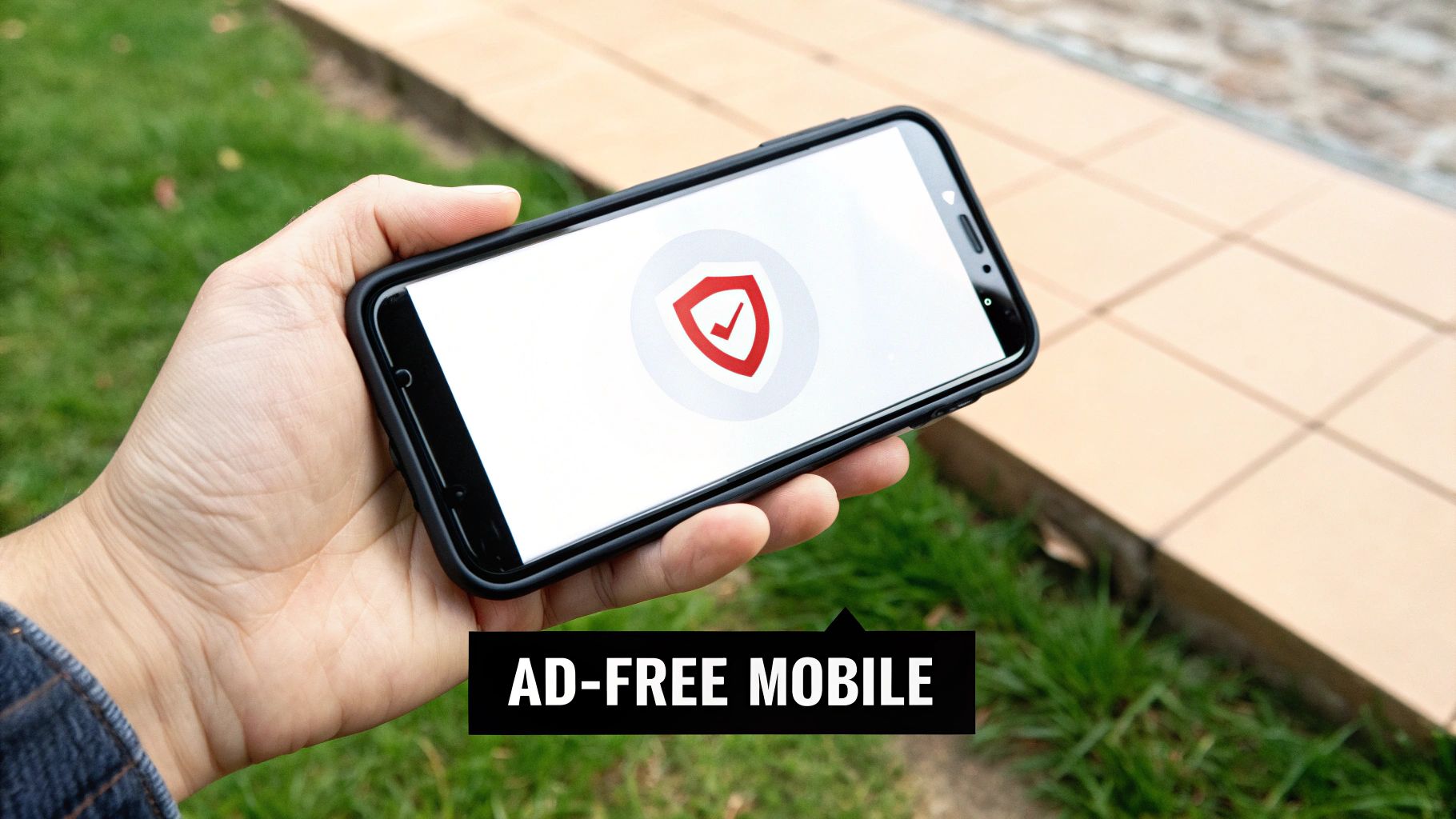
So, how do they pull it off? These apps intercept the data coming from YouTube's servers and strip out the ad content before it ever gets to your screen. It's a constant game of cat and mouse—YouTube updates its official app, and the mod developers quickly push out a new version to keep things working. It's a surprisingly popular approach.
Weighing the Risks and Rewards
The biggest reward, of course, is a smooth, ad-free YouTube experience on your phone. But this convenience comes with some serious risks you need to consider.
Since these apps aren't on the Google Play Store or Apple's App Store, you have to download and install them from other websites. This process is called sideloading, and it opens you up to some potential security issues.
Without the safety checks of an official app store, you could accidentally download a version bundled with malware or something that compromises your data. It's absolutely vital to brush up on mobile app security best practices before even thinking about going down this path. (https://accountshare.ai/blogs/new/mobile-app-security-best-practices)
On top of that, using these apps is a clear violation of YouTube’s Terms of Service.
While getting your account banned is pretty rare, it's not completely out of the question. A more likely headache is the app suddenly breaking after a YouTube update, forcing you to hunt down a new version or find another way to watch.
The sheer demand for these apps shows just how much people want to watch content without interruptions. And with YouTube’s user base expected to cross one billion by 2026, the market for these workarounds is only going to get bigger. Ultimately, you have to decide if the convenience is worth the potential security and account risks.
So, we've talked about all the clever ways to get around YouTube ads for free. But what about the official, paid route? Let's take a look at whether YouTube Premium is actually worth the monthly subscription fee.
Think of Premium as the all-access pass. It's the simplest, most reliable way to kill ads across every single device you use—your smart TV, your phone, your tablet, you name it. There's no setup, no browser extensions to manage, and no worrying about YouTube finding a way to block your blocker. It just works.
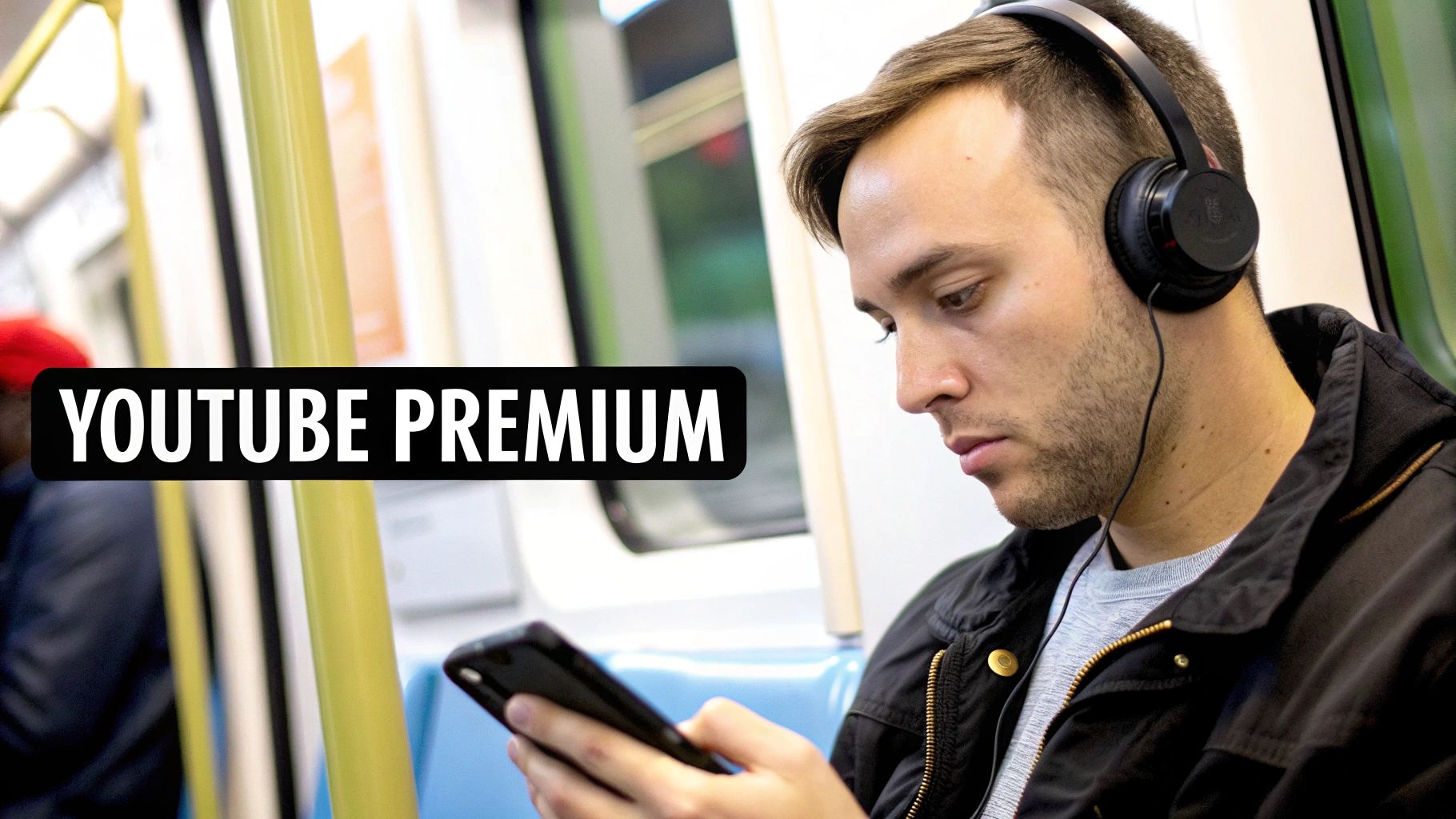
The main selling point is, of course, a completely ad-free experience. But the real value is in the bundle of perks that come with it. You can finally lock your phone and keep the audio from a video playing in the background—an absolute game-changer for listening to podcasts, music mixes, or long-form interviews.
And for anyone who travels or has a long commute, the ability to download videos for offline viewing is a lifesaver. No more depending on spotty airport Wi-Fi or chewing through your data plan. Just save what you want to watch ahead of time. For many people, that feature alone makes the subscription a no-brainer.
More Than Just No Ads
The big question is whether it's worth the cost for you. If you only watch YouTube on your desktop and have a solid ad blocker installed, you're already getting the core benefit for free. In that case, paying a monthly fee might feel a little pointless.
But if you're constantly watching on your phone, the combination of no ads, background play, and offline downloads creates a genuinely better experience. It means you don't have to mess with clunky, third-party apps that might not even be safe.
At the end of the day, it's a simple trade-off: convenience versus cost. Ad blockers are free but need a bit of upkeep and are mostly limited to browsers. Premium is a paid, set-it-and-forget-it solution that works everywhere and throws in extra features.
Here's a quick breakdown of how the two approaches stack up.
YouTube Premium vs. Free with Ad Blockers
| Feature | YouTube Premium | Free with Ad Blocker |
|---|---|---|
| Cost | Monthly subscription fee | Free (though some encourage donations) |
| Device Support | Works on all devices (PC, mobile, TV, etc.) | Primarily works on desktop browsers; mobile is very limited |
| Ad-Free Viewing | Yes, guaranteed | Yes, but can break when YouTube updates its detection methods |
| Background Play | Yes, built-in feature on mobile | No, requires third-party apps or workarounds |
| Offline Downloads | Yes, built-in feature on mobile | No, requires third-party apps or websites |
| YouTube Music | Includes full access to YouTube Music Premium | No access to the premium music service |
| Creator Support | Supports creators directly through subscription revenue | Blocks ad revenue, which can hurt creators |
As you can see, Premium is a complete package. Free ad blockers are more of a single-purpose tool.
Don't forget, a Premium subscription also bundles in full access to YouTube Music Premium, which is a direct competitor to services like Spotify and Apple Music. If you're already paying for one of those, switching could actually save you some money by consolidating your subscriptions. To get the full picture, check out our in-depth guide to YouTube Premium benefits.
With over 125 million subscribers globally, it’s clear a lot of people feel the bundled perks are more than enough to justify the price.
A Few Clever Tricks to Dodge Ad Interruptions
If you're not in a position to install new software or spring for a paid subscription, don't worry. There are a handful of clever workarounds you can use on the fly to deal with YouTube ads. These aren't permanent solutions, but they're perfect for a quick fix.
The Old URL Trick
Here’s a classic trick that sometimes still works, and it couldn’t be simpler. When you land on a video, just pop a single period . into the URL right after the .com part. So, youtube.com/watch... becomes youtube.com./watch....
This little tweak can occasionally confuse the ad-serving system and let you skip straight to the video. YouTube is constantly patching these kinds of loopholes, so your mileage may vary, but it costs nothing to try.
Watch Through an Alternative "Front-End"
A much more reliable method is to use what's known as an "alternative front-end." These are essentially different websites that pull in YouTube's videos but wrap them in their own clean, ad-free player. It’s like watching the same movie, just in a much nicer, quieter theater.
A couple of the most popular options are:
- Invidious: An open-source and privacy-first portal to YouTube. No ads, no Google tracking.
- Piped: Another great choice that focuses on privacy, streaming videos without your device ever talking directly to Google's servers.
All you have to do is copy the original YouTube video link and paste it into one of these sites. The video will load up, completely free of ads.
These platforms do more than just block ads; they're built from the ground up to protect your privacy. They act as a shield, preventing Google from logging your viewing history and building a profile on you.
This approach is a lifesaver when you're on a device where you can't install an ad blocker, like a locked-down work computer or when you're borrowing a friend's laptop. It's a powerful way to get an ad-free experience with a simple copy-paste.
Your Top Questions About Blocking YouTube Ads, Answered
Once you start looking for ways to get rid of YouTube ads, you’ll probably find yourself asking the same questions everyone else does. It can be a little confusing trying to figure out ad blockers, VPNs, and what YouTube itself actually allows. Let's break down some of the most common concerns with some straight-to-the-point answers.
The biggest worry I hear is: "Can YouTube ban my account for using an ad blocker?" While it's technically a violation of their Terms of Service, YouTube has always gone after the technology, not the users. You might get a pop-up notice asking you to turn it off, but an actual account ban for simply using an ad blocker is incredibly rare.
Common Concerns and Clear Answers
Another frequent question is whether a VPN will take care of the ads. The short answer is usually no. A VPN's main purpose is to secure your connection and hide your IP address for privacy—it isn't designed to filter out content like ads. That said, some of the bigger VPN providers are now including ad-blocking as a built-in feature, so it's something to look for if you're shopping for a new service.
Just remember, YouTube and ad-blocker developers are in a constant game of cat and mouse. If ads suddenly reappear, it usually just means YouTube found a new way around the block, and your ad blocker needs a quick update to catch up.
So, what if your ad blocker is doing its job perfectly, but you still want to help out your favorite creators?
- Go Direct: The best way to support a channel is often directly. Think about using features like channel memberships, sending a Super Chat during a live stream, or even buying some of their merchandise.
- Other Platforms: Many creators also have a Patreon you can join. Don't underestimate the power of simple engagement, either—liking, commenting, and sharing their videos genuinely helps them with the YouTube algorithm.
- Whitelist Them: Most ad blockers have a "whitelist" feature. This lets you turn off the blocker for specific channels, so you can see their ads (and they get paid) while keeping your ad-free experience everywhere else.
Troubleshooting and Subscription Management
If your ad blocker suddenly stops working, don't panic. The first thing you should always try is heading into the extension's settings and manually updating its filter lists. If that doesn't do the trick, clearing your browser's cache often solves the issue.
This kind of proactive digital housekeeping is a great habit to get into. Just like you'd update an app, it's smart to periodically check on your paid subscriptions to make sure you're still using them. If you're feeling overwhelmed by all the services you pay for, our guide on how to cancel unwanted subscriptions can help you cut back and save some cash.
At AccountShare, our goal is to make premium digital tools and entertainment more affordable. Instead of footing the full bill for every subscription, you can join a sharing group to split the cost safely. Explore shared subscriptions on AccountShare today!
